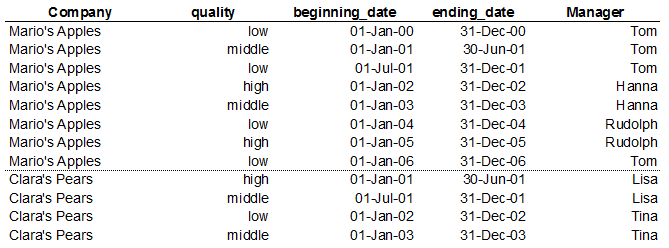- Home
- /
- Programming
- /
- SAS Procedures
- /
- Creation of up-counting ID variables per group, not according to disti...
- RSS Feed
- Mark Topic as New
- Mark Topic as Read
- Float this Topic for Current User
- Bookmark
- Subscribe
- Mute
- Printer Friendly Page
- Mark as New
- Bookmark
- Subscribe
- Mute
- RSS Feed
- Permalink
- Report Inappropriate Content
Dear community,
I would be very glad, if you could help concerning the following issue.
Please consider the following table (as also attached as sas7bdat) I am faced with
, as well as the table I do want to end up with:
The scenario, thus, is the following:
I have a table with companies. This table contains "beginning_date" as well as "ending_date" - this variables define, from "when to when" the row-information hold valid. As an example, I added information towards the "quality" of the offered product.
Object of interest is the "manager" - I want to end up with a data set, listing up
which manager
works in which time span
for which company, i.e.:

"Tom" at "Mario's Apples" is the problem -
I cannot just simply take
proc means data=have noprint;
output out=list (drop = _FREQ_ _TYPE_)
min(beginning_date) = beg_date_manager
max(ending_date) = end_date_manager;
by
company
Manager;
run;, because then it would appear as if "Tom" would have worked all time at "Mario's Apples".
If I had this nice ID-variable, I were able to include it in my by-statement and I was fine.
So if someone could please tell me how to create this very ID (because in general it would help me to know how to do it) or otherwise could provide me with a means of how to solve my problem, for the means of which I have thought of appears as rather clumsy to me ("there for sure is a much more sophisticated solution"), I would be very glad.
Yours sincerely,
Sinistrum
Accepted Solutions
- Mark as New
- Bookmark
- Subscribe
- Mute
- RSS Feed
- Permalink
- Report Inappropriate Content
Post test data in the form of a datastep in the body of the post, I don't download files, or type in test data. So this is just a rough outline. You should just be able to increment at each new manager:
data want; set have; by company manager notsorted; retain id; if first.company then id=0; if first.manager then id=sum(id,1); run;
- Mark as New
- Bookmark
- Subscribe
- Mute
- RSS Feed
- Permalink
- Report Inappropriate Content
Post test data in the form of a datastep in the body of the post, I don't download files, or type in test data. So this is just a rough outline. You should just be able to increment at each new manager:
data want; set have; by company manager notsorted; retain id; if first.company then id=0; if first.manager then id=sum(id,1); run;
- Mark as New
- Bookmark
- Subscribe
- Mute
- RSS Feed
- Permalink
- Report Inappropriate Content
Thank you very much indeed -
it once again is truly breathtaking, how fast I receive responses.
April 27 – 30 | Gaylord Texan | Grapevine, Texas
Registration is open
Walk in ready to learn. Walk out ready to deliver. This is the data and AI conference you can't afford to miss.
Register now and lock in 2025 pricing—just $495!
Learn the difference between classical and Bayesian statistical approaches and see a few PROC examples to perform Bayesian analysis in this video.
Find more tutorials on the SAS Users YouTube channel.
SAS Training: Just a Click Away
Ready to level-up your skills? Choose your own adventure.




